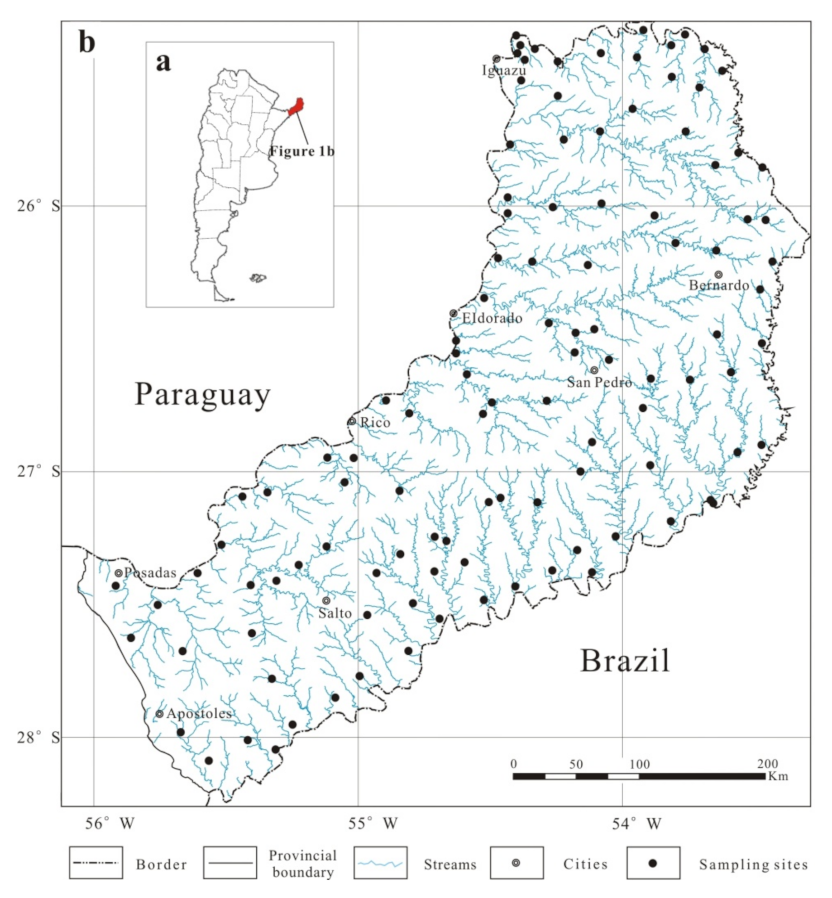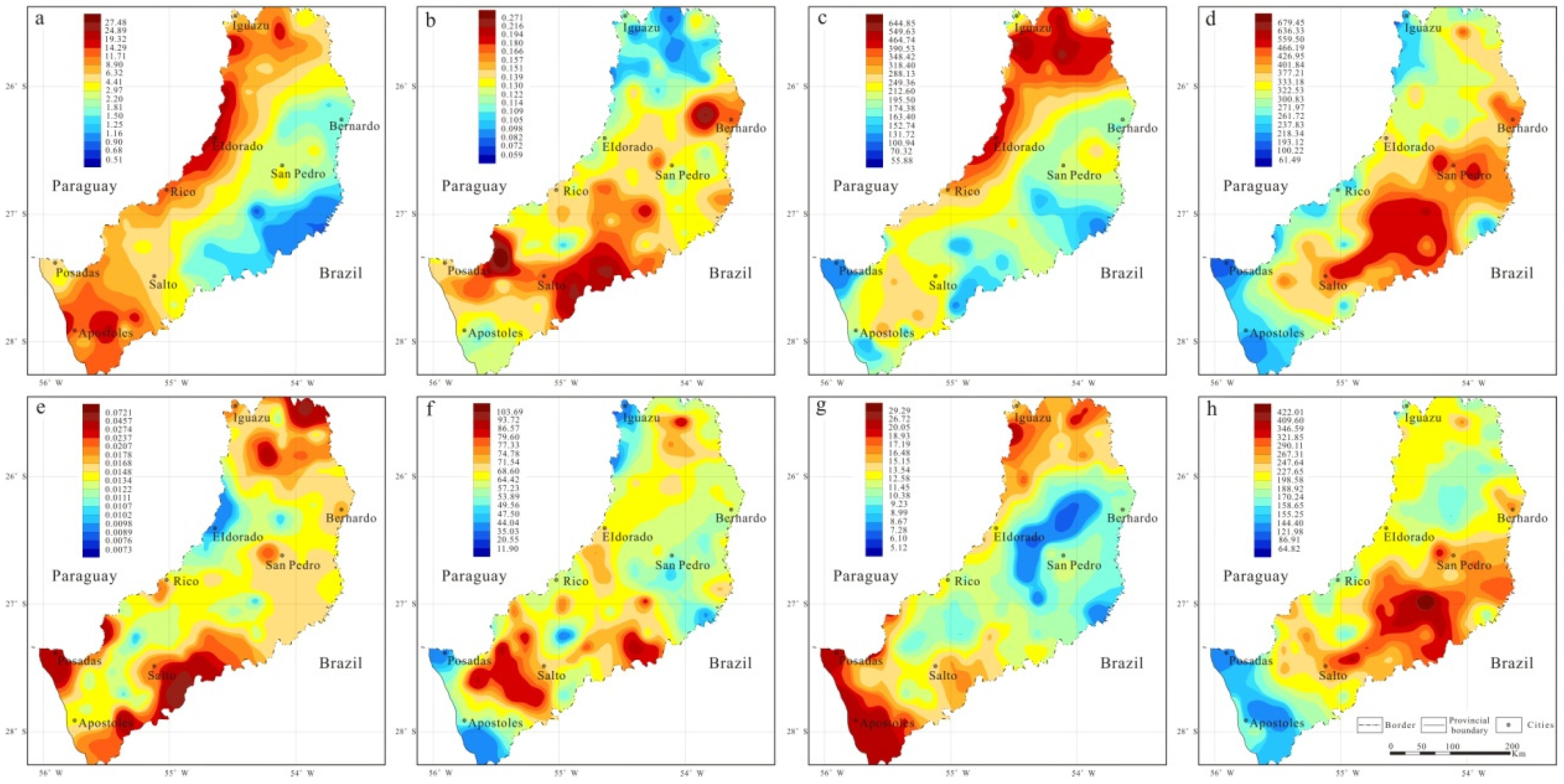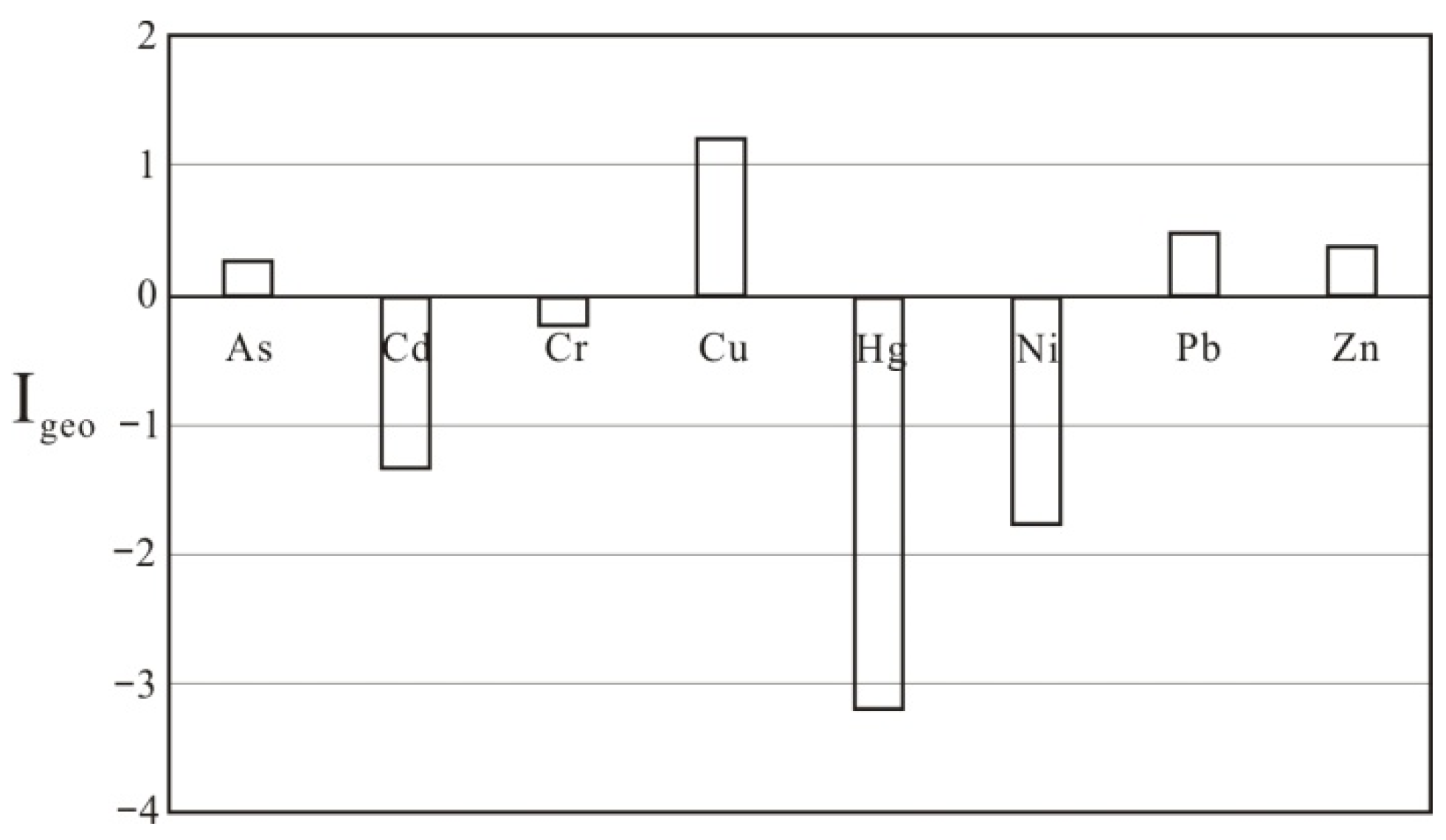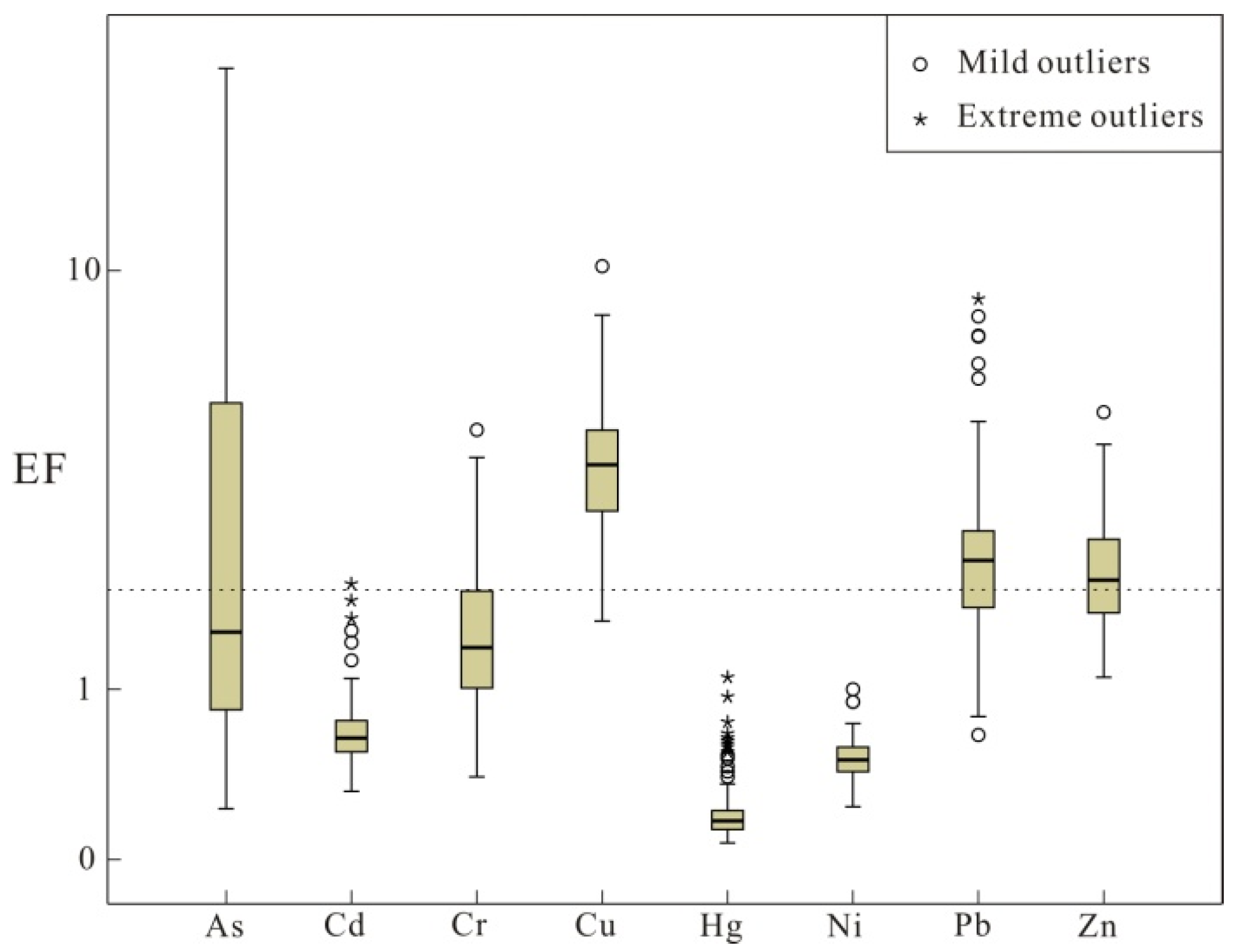Concentration, Spatial Distribution and Potential Ecological Risk of Heavy Metals in Stream Sediments of the Misiones Province, Argentina
Abstract
:1. Introduction
2. Materials and Methods
2.1. Sampling
2.2. Sample Processing and Analysis
2.3. Evaluation Method
2.3.1. Geoaccumulation Index (Igeo)
2.3.2. Enrichment Factor (EF)
2.3.3. Potential Ecological Risk Index (PERI)
2.4. Data Processing
3. Results and Discussion
3.1. The Concentration of Heavy Metals
3.2. The Distribution Characteristics of Heavy Metals
3.3. The Pollution and Ecological Risk Assessment of Heavy Metals
3.3.1. Igeo
3.3.2. EF
3.3.3. PERI
4. Conclusions
Author Contributions
Funding
Conflicts of Interest
References
- Zhu, Q.Q.; Wang, Z.L. Distribution characteristics and source analysis of heavy metals in sediments of the main river systems in China. Earth Environ. 2012, 40, 305–313. [Google Scholar]
- Horowitz, A.J.; Rlrick, K.A. The relation of stream sediment surface area, grain size and composition to trace element chemistry. Appl. Geochem. 1987, 2, 437–451. [Google Scholar] [CrossRef]
- Xie, X.J.; Zhou, G.H. Multi-purpose regional geochemical mapping and multi-level environmental geochemistry monitoring network: Its basic concept and methodology. Geol. Bull. China 2002, 21, 809–816. [Google Scholar]
- Simex, S.A.; Helz, G.R. Regional geochemistry of trace elements in Checapeake Bay. Environ. Geol. 1981, 3, 315–323. [Google Scholar] [CrossRef]
- Grunsky, E.C.; Drew, L.J.; Sutphin, D.M. Process recognition in multi-element soil and stream-sediment geochemical data. Appl. Geochem. 2009, 24, 1602–1616. [Google Scholar] [CrossRef]
- Albanese, S.; Taiani, M.V.E.; De Vivo, B.; Lima, A. An environmental epidemiological study based on the stream sediment geochemistry of the Salerno province (Campania region, Southern Italy). J. Geochem. Explor. 2013, 131, 59–66. [Google Scholar] [CrossRef]
- Horasan, B.Y.; Arik, F. Assessing heavy metal pollution in the surface soils of central anatolia region of Turkey. Carpath. J. Earth Environ. Sci. 2019, 14, 107–118. [Google Scholar] [CrossRef]
- Xie, X.J.; Cheng, H.X. The suitability of floodplain sediment as a global sampling medium: Evidence from China. J. Geochem. Explor. 1997, 58, 51–62. [Google Scholar] [CrossRef]
- Wang, L.; Wang, Y.P.; Xu, C.X.; An, Z.Y. Pollution characteristics and ecological risk assessment of heavy metals in the surface sediments of the Yangtze River, China. Environ. Sci. 2012, 33, 2599–2606. [Google Scholar]
- Zheng, J.P.; Jiao, X.M.; Fang, N.J.; Wang, C.Y.; Yuang, G.W.; Lv, Y.; Zhou, C.F. Sources and risk assessment of heavy metals in sediments in Jiangsu coastal areas, China. China Environ. Sci. 2017, 37, 1514–1522. [Google Scholar]
- Bilali, L.E.; Rasmussen, P.E.; Hall, G.E.M. Role of sediment composition in trace metal distribution in lake sediments. Appl. Geochem. 2002, 17, 1171–1181. [Google Scholar] [CrossRef]
- Lin, Q.; Liu, E.F.; Zhang, E.L.; Li, K.; Shen, J. Spatial distribution, contaminationand ecological risk assessment of heavy metals in surface sediments of Erhai Lake, a large eutrophic plateau lake in southwest China. CATENA 2016, 145, 193–203. [Google Scholar] [CrossRef]
- Alain, L.; Raphal, B.; Alain, D.; Axel, T.; Virginie, C.H. Phthalate pollution in an Amazonian rainforest. Environ. Sci. Pollut. Res. 2016, 16, 16865–16872. [Google Scholar]
- Rämö, O.T.; Heikkilä, P.A.; Pulkkinen, A.H. Geochemistry of Paraná-Etendeka basalts from Misiones, Argentina: Some new insights into the petrogenesis of high-Ti continental flood basalts. J. S. Am. Earth Sci. 2016, 67, 25–39. [Google Scholar] [CrossRef]
- Chen, Y.M.; Zhang, C.; Chen, X.F.; Chen, X.F.; Zhao, H.J. South America Geological Minerals and Mining Development; China University of Geosciences Press: Wuhan, China, 2018; pp. 1–48. [Google Scholar]
- Lavado, R.S.; Rodriguez, M.B.; Scheiner, J.D.; Taboada, M.A.; Rubio, G.; Alvarez, R.; Alconada, M.; Zubillaga, M.S. Toxic metals in soils of Argentina: Comparison between urban and agricultural soils. Commun. Soil Sci. Plant Anal. 1998, 29, 1913–1917. [Google Scholar] [CrossRef]
- Lavado, R.S.; Zubillaga, M.S.; Álvarez, R.; Taboada, M.A. Baseline levels of potentially toxic elements in Pampas soils. Soil Sed. Contam. 2004, 13, 329–339. [Google Scholar] [CrossRef]
- Cittadino, A.; Ocello, N.; Majul, M.V.; Ajhuacho, R.; Dietrich, P.; Igarzabal, M.A. Heavy metal pollution and health risk assessment of soils from open dumps in the Metropolitan Area of Buenos Aires, Argentina. Environ. Monit. Assess. 2020, 192, 291. [Google Scholar] [CrossRef]
- Boglione, R.; Griffa, C.; Panigatti, M.C.; Keller, S.; Schierano, C.M.; Asforno, M. Arsenic adsorption by soil from Misiones province, Argentina. Environ. Technol. Innov. 2019, 13, 30–36. [Google Scholar] [CrossRef]
- Wang, X.Q.; Chi, Q.H.; Liu, H.Y.; Nie, L.S.; Zhang, B.M. Wide-spaced sampling for delineation of geochemical provinces in desert terrains, northwestern China. Geochem. Explor. Environ. Anal. 2007, 2, 153–161. [Google Scholar] [CrossRef]
- Wang, X.Q.; Xu, S.F.; Zhang, B.M.; Zhao, S.D. Deep-penetrating geochemistry for sandstone-type uranium deposits in the Turpan–Hami basin, north-western China. Appl. Geochem. 2011, 12, 2238–2246. [Google Scholar] [CrossRef]
- Wang, X.Q.; Zhang, B.M.; Lin, X.; Xu, S.F.; Yao, W.S.; Ye, R. Geochemical challenges of diverse regolith-covered terrains for mineral exploration in China. Ore. Geol. Rev. 2016, 73, 417–431. [Google Scholar]
- Tian, M.; Wang, X.Q.; Nie, L.S.; Liu, H.L.; Wang, W.; Yan, T.T. Spatial distributions and the identifification of ore-related anomalies of Cu across the boundary area of China and Mongolia. J. Geochem. Explor. 2019, 197, 37–47. [Google Scholar] [CrossRef]
- Müller, G. Index of geoaccumulation in sediments of the Rhine River. Geojournal 1969, 2, 108–118. [Google Scholar]
- Castro, L.N.; Rendina, A.E.; Orgeira, M.J. Assessment of toxic metal contamination using a regional lithogenic geochemical background, Pampean area river basin, Argentina. Sci. Total Environ. 2018, 627, 125–133. [Google Scholar] [CrossRef]
- Turekian, K.K.; Wedepohl, K.H. Distribution of the elements in some major units of the earth′s crust. Geol. Soc. Am. 1961, 72, 175–192. [Google Scholar] [CrossRef]
- Magni, L.F.; Castro, L.N.; Rendina, A.E. Evaluation of heavy metal contamination levels in river sediments and their risk to human health in urban areas: A case study in the Matanza-Riachuelo Basin, Argentina. Environ. Res. 2021, 197, 110979. [Google Scholar] [CrossRef] [PubMed]
- Abrahim, G.M.S.; Parker, R.J. Assessment of toxic metal enrichment factors and the degree of contamination in marine sediments from Tamaki Estuary, Auckland, New Zealand. Environ. Monit. Assess. 2008, 136, 227–238. [Google Scholar] [CrossRef]
- Nowrouzi, M.; Pourkhabbaz, A. Application of geoaccumulation index and enrichment factor for assessing metal contamination in the sediments of Hara Biosphere Reserve, Iran. Chem. Speciat. Bioavailab. 2014, 26, 99–105. [Google Scholar] [CrossRef] [Green Version]
- Williams, J.A.; Antoine, J. Evaluation of the elemental pollution status of Jamaican surface sediments using enrichment factor, geoaccumulation index, ecological risk and potential ecological risk index. Marine Pollut. Bull. 2020, 157, 111288. [Google Scholar] [CrossRef]
- Zhang, H.H.; Chen, J.J.; Zhu, L.; Yang, G.; Li, D. Anthropogenic mercury enrichment factors and contributions in soils of Guangdong Province, South China. J. Geochem. Explor. 2014, 144, 312–319. [Google Scholar] [CrossRef]
- Barbier, M. The importance of enrichment factor (EF) and Geoaccumulation index (Igeo) to evaluate the soil contamination. J. Geol. Geophys. 2016, 5, 1–4. [Google Scholar] [CrossRef]
- Hakanson, L. An ecological risk index for aquatic pollution control: A sedimentological approach. Water Res. 1980, 14, 975–1001. [Google Scholar] [CrossRef]
- Saraee, K.R.E.; Abdi, M.R.; Naghavi, K.; Saion, E.; Shafaei, M.A.; Soltani, N. Distribution of heavy metals in surface sediments from the South China Sea ecosystem, Malaysia. Environ. Monit. Assess. 2011, 183, 545–554. [Google Scholar] [CrossRef]
- Coskun, A.; Horasan, B.Y.; Ozturk, A. Heavy metal distribution in stream sediments and potential ecological risk assessment in Konya Northeast region. Environ. Earth Sci. 2021, 80, 181. [Google Scholar] [CrossRef]
- Wedepohl, K.H. The composition of the continental crust. Geochim. Cosmochim. Acta 1995, 59, 1217–1232. [Google Scholar] [CrossRef]
- Rudnick, R.L.; Gao, S. The Composition of the continental crust. In The Crust. Treatise on Geochemistry; Holland, H.D., Turekian, K.K., Eds.; Elsevier-Pergamon: Oxford, UK, 2003; Volume 2, pp. 1–64. [Google Scholar]
- Wang, X.S.; Qin, Y. Application of lognormal distribution plot to interpreting sources and determining geochemical background levels of heavy metals in Xuzhou urban soils, Jiangsu province. Geochimica 2007, 36, 98–102. [Google Scholar]
- RAIS (The Risk Assessment Information System). Toxicity Values. 2021. Available online: https://rais.ornl.gov/tutorials/toxvals.html#2.4%20Derivation%20of%20Inhalation%20RfDs%20and%20Slope%20Factors (accessed on 12 July 2021).
- Environment Agency. Soil Screening Values for Use in UK Ecological Risk Assessment; Technical Report P5- 091/TR1; Environment Agency: Bristol, UK, 2004. [Google Scholar]
- Zheng, L.P.; Wang, G.Q.; Long, T.; Lin, Y.S.; Feng, Y.H.; Zhang, Y.; Zhao, X. A study of risk-based ecological soil screening levels among different countries and its implication for China. Asian J. Ecotoxicol. 2018, 13, 39–49. [Google Scholar]
- Canadian Council of Ministers of the Environment. Canadian Soil Quality Guidelines for the Protection of Environmental and Human Health: Polychlorinated Biphenyls (Total). Canadian Environmental Quality Guidelines; Canadian Council of Ministers of the Environment: Winnipeg, MB, Canada, 1999. [Google Scholar]
- Chaparro, M.A.E.; Bidegain, J.C.; Sinito, A.M.; Jurado, S.S.; Gogorza, C.S.G. Magnetic studies applied to different environments (soils and stream sediments) from a relatively polluted area in Buenos Aires Province, Argentina. Environ. Geol. 2004, 45, 645–664. [Google Scholar] [CrossRef]
- Borg, H.; Jonsson, P. Large-scale metal distribution in Baltic Sea sediments. Marine Pollut. Bull. 1996, 32, 8–21. [Google Scholar] [CrossRef]
- He, S.L.; Cheng, G.F.; Liu, Y.Z.; Chen, Z.; Hou, C.L.; Mou, J.; Luo, X.M. Resource potential and prospecting methods of gold geochemical blocks in southwestern Guizhou, China. Acta Mineral. Sinica 2007, 27, 477–482. [Google Scholar]
- Wu, Y.; Wang, S.X.; Streets, D.G.; Hao, J.M.; Chan, M.; Jiang, J.K. Trends in anthropogenic mercury emissions in China from 1995 to 2003. Environ. Sci. Technol. 2006, 40, 5312–5318. [Google Scholar] [CrossRef] [PubMed]
- Wang, S.L.; Wu, W. Research progress on soil mercury pollution ecology in Guizhou, China. Innov. Appl. Sci. Technol. 2015, 27, 173. [Google Scholar]
- Chen, T.B.; Hang, M.H.; Hang, H.Z.; Zhou, H.Y. A study on heavy metal pollution in soils in Hongkong. Acta Geogr. Sinica 1997, 52, 228–236. [Google Scholar]
- Zakir, H.M.; Shikazono, N.; Otomo, K. Geochemical distribution of trace metals and assessment of anthropogenic pollution in sediments of Old Nakagawa River, Tokyo, Japan. Am. J. Environ. Sci. 2008, 4, 654. [Google Scholar] [CrossRef]
- Michalak, I.; Saeid, A.; Chojnacka, K.; Gramza, M. Trace elements as fertilizer micronutrients. In Recent Advances in Trace Elements; Chojnacka, K., Saeid, A., Eds.; Wiley-Blackwell: Oxford, UK, 2018; pp. 299–318. [Google Scholar]




| Parameters | Sample Preparation | Analytical Method | Detection Limit (ppm) | Reportable Rate (%) | Passing Rates (%) | ||
|---|---|---|---|---|---|---|---|
| SRMs | Laboratory Replicates | Field Duplicate | |||||
| As | Aqua regia | HG-AFS | 0.1 | 99.7 | 99.8 | 98.5 | 94.9 |
| Cd | Acid digestion | ICP-MS | 0.01 | 99.9 | 99.7 | 100 | 95.3 |
| Cr | Powder pellet | XRF | 0.5 | 99.8 | 99.7 | 98.6 | 95.8 |
| Cu | Acid digestion | ICP-MS | 1 | 100 | 100 | 99.7 | 98.1 |
| Hg | Aqua regia | CV-AFS | 0.0005 | 100 | 99 | 96.2 | 88.8 |
| Ni | Acid digestion | ICP-MS | 0.5 | 99.9 | 100 | 99.7 | 97.7 |
| Pb | Acid digestion | ICP-MS | 1 | 100 | 100 | 99.9 | 99.5 |
| Zn | Acid digestion | ICP-MS | 2 | 100 | 99.8 | 100 | 98.1 |
| Igeo | Class | Contamination Grades |
|---|---|---|
| <0 | 1 | uncontaminated |
| 0–1 | 2 | mild contamination |
| 1–2 | 3 | moderately contaminated |
| 2–3 | 4 | moderate to heavily contaminated |
| 3–4 | 5 | heavily contaminated |
| 4–5 | 6 | heavily to extremely contaminated |
| 5–6 | 7 | extremely contaminated |
| EF | Degree of Enrichment | Pollution Level |
|---|---|---|
| <2 | no or minor | uncontaminated |
| 2–5 | moderate | moderately contaminated |
| 5–20 | signifcant | moderately severe contaminated |
| 20–40 | very high | severe contaminated |
| ≥40 | extremely high | extremely severe contaminated |
| Eir | Ecological Risk Level | RI | Comprehensive Potential Ecological Risk Level |
|---|---|---|---|
| <40 | low | <110 | low |
| 40–80 | moderate | 110–220 | moderate |
| 80–160 | considerable | 220–440 | considerable |
| 160–320 | high | ≥440 | very high |
| ≥320 | Very high | / | / |
| Elements | Range | AV | ME | SD | EC | VC | a | b | c | d | e | f |
|---|---|---|---|---|---|---|---|---|---|---|---|---|
| As | 0.42–33.77 | 6.48 | 2.97 | 7.42 | 1.19 | 1.14 | 2.5 | 2 | 7.7 | - | 46 | 12 |
| Cd | 0.028–0.502 | 0.14 | 0.13 | 0.06 | 1.62 | 0.4 | 0.08 | 0.22 | 0.73 | 1.15 | 0.36 | 1.4 |
| Cr | 34.70–696.90 | 252.98 | 212.60 | 137.92 | 1.57 | 0.55 | 135 | 170 | 55 | 21.1 | 34/130 | 64 |
| Cu | 20.61–966.85 | 339.23 | 322.53 | 146.79 | 11.95 | 0.43 | 27 | 87 | 24 | 88.4 | 49 | 63 |
| Hg | 0.007–0.078 | 0.017 | 0.013 | 0.013 | 0.45 | 0.75 | 0.03 | 0.09 | 0.07 | 0.06 | - | 6.6 |
| Ni | 4.28–104.79 | 61.98 | 64.42 | 20.18 | 1.09 | 0.33 | 59 | 130 | 18.5 | 25.1 | 130 | 45 |
| Pb | 4.06–34.12 | 13.54 | 12.58 | 5.63 | 1.14 | 0.42 | 11 | 6 | 20 | 167.9 | 56 | 70 |
| Zn | 28.70–583.40 | 221.96 | 198.85 | 92.34 | 2.76 | 0.42 | 72 | 105 | 58.5 | 90.1 | 79 | 250 |
| Elements | As | Cd | Cr | Cu | Hg | Ni | Pb | Zn |
|---|---|---|---|---|---|---|---|---|
| As | 1 | |||||||
| Cd | −0.163 | 1 | ||||||
| Cr | −0.256 ** | −0.217 * | 1 | |||||
| Cu | −0.190 * | 0.350 ** | 0.047 | 1 | ||||
| Hg | 0.692 ** | 0.258 ** | −0.322 ** | −0.154 | 1 | |||
| Ni | 0.055 | 0.396 ** | 0.320 ** | 0.651 ** | −0.182 * | 1 | ||
| Pb | 0.428 ** | 0.004 | 0.288 ** | 0.003 | 0.298 ** | −0.018 | 1 | |
| Zn | −0.153 | 0.374 ** | 0.075 | 0.890 ** | −0.121 | 0.579 ** | 0.079 | 1 |
| Elements | F1 | F2 |
|---|---|---|
| As | −0.13 | 0.90 |
| Cd | 0.56 | −0.24 |
| Cr | 0.67 | 0.13 |
| Cu | 0.92 | −0.06 |
| Hg | −0.13 | 0.86 |
| Ni | 0.82 | 0.19 |
| Pb | 0.32 | 0.65 |
| Zn | 0.91 | −0.02 |
| Parameters | Eir | RI | |||||||
|---|---|---|---|---|---|---|---|---|---|
| As | Cd | Cr | Cu | Hg | Ni | Pb | Zn | ||
| Max | 168.85 | 68.44 | 8.20 | 55.57 | 34.76 | 4.03 | 28.43 | 5.56 | 240.44 |
| Min | 2.11 | 3.81 | 0.41 | 1.18 | 2.97 | 0.16 | 3.38 | 0.27 | 18.26 |
| AV | 32.41 | 18.95 | 2.98 | 19.50 | 7.74 | 2.38 | 11.28 | 2.11 | 97.35 |
| ROC | 33.29% | 19.47% | 3.06% | 20.03% | 7.95% | 2.45% | 11.59% | 2.16% | 100% |
Publisher’s Note: MDPI stays neutral with regard to jurisdictional claims in published maps and institutional affiliations. |
© 2021 by the authors. Licensee MDPI, Basel, Switzerland. This article is an open access article distributed under the terms and conditions of the Creative Commons Attribution (CC BY) license (https://creativecommons.org/licenses/by/4.0/).
Share and Cite
Zhao, D.; Chen, Y.; Zhang, W.; Chen, X.; Chen, X.; Zhang, F. Concentration, Spatial Distribution and Potential Ecological Risk of Heavy Metals in Stream Sediments of the Misiones Province, Argentina. Minerals 2021, 11, 1112. https://doi.org/10.3390/min11101112
Zhao D, Chen Y, Zhang W, Chen X, Chen X, Zhang F. Concentration, Spatial Distribution and Potential Ecological Risk of Heavy Metals in Stream Sediments of the Misiones Province, Argentina. Minerals. 2021; 11(10):1112. https://doi.org/10.3390/min11101112
Chicago/Turabian StyleZhao, Dongjie, Yuming Chen, Weibo Zhang, Xifeng Chen, Xiufa Chen, and Fuliang Zhang. 2021. "Concentration, Spatial Distribution and Potential Ecological Risk of Heavy Metals in Stream Sediments of the Misiones Province, Argentina" Minerals 11, no. 10: 1112. https://doi.org/10.3390/min11101112
APA StyleZhao, D., Chen, Y., Zhang, W., Chen, X., Chen, X., & Zhang, F. (2021). Concentration, Spatial Distribution and Potential Ecological Risk of Heavy Metals in Stream Sediments of the Misiones Province, Argentina. Minerals, 11(10), 1112. https://doi.org/10.3390/min11101112






